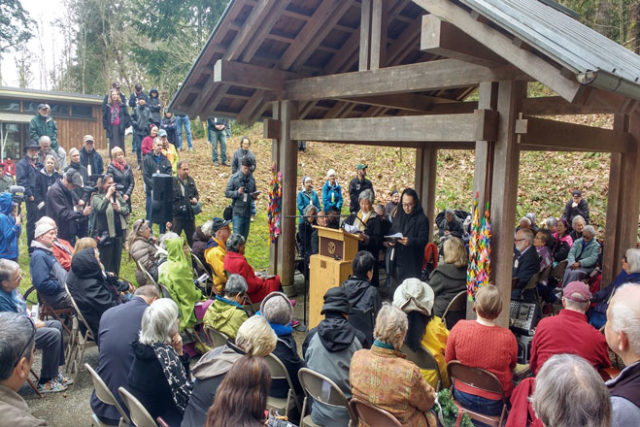
By Shihou Sasaki
Unlike 15 years ago, Clarence Moriwaki, president of the Bainbridge Island Japanese American Community, did not hear much crows’ calls last Thursday. Still, on a late sunny morning, hundreds of friends joined the annual ceremony at the Bainbridge Island Japanese American Exclusion Memorial and shared a moment of one of the most important lessons that the U.S. citizens have learned.
The 75th anniversary ceremony of Bainbridge Island’s Japanese American exclusion was held at the memorial site, inviting over a dozen of the survivors of the mass removal, Governor Jay Inslee, Japanese Ambassador Kenichiro Sasae and various community leaders.
This is the 15th year since the Bainbridge Island Japanese American Exclusion Memorial was dedicated.
The Bainbridge Island Nikkei group was first targeted for mass exclusion under Executive Order 9066, possibly because of its location between the U.S. Naval shipyard and Seattle’s defense industry.
Lilly Kodama of Bainbridge Island Japanese American Community said that the island’s community has been very unique, strongly united in helping each other.
“Someone called the island like a ship,” she said. “We have to get along to get the ship to go.”
Kodama recalled the unity of the attendees at the ceremony, saying, “It was touching,” But she also lost her voice to tears, remembering that the large number of the incarceration survivors are now gone, including notable community members like the iconic Fumiko Hayashida and Kodama’s brother, Frank Kitamoto.
The number of attendees who experienced the mass-removal from Bainbridge Island was down to about a dozen, now that 75 years have passed.
But Governor Inslee said that he still can hear the voice of Hayashida who testified about her exclusion experience at Congress to support a bill for the memorial, which was to be installed as a satellite of the Minidoka National Historic Site. He said that Hayashida’s voice can still be heard as the nation struggles with power of fear and hope of courage, compassion and community. Sasae said that he realized how significant the location has been to the community and also to the cause of social justice.
“I thought I knew Japanese Americans. I’ve visited places on the West Coast and other places,” Sasae said. “But I realized after coming here why the governor suggested for me to come with him and to share the moment with all of you. As I was listening to what people said, all the moments of Japanese American suffering on this island sink into my mind and heart.”
Moriwaki shared a watch, which was presented by Hayashida. After each speaker concluded her and his remarks, he checked the time and described what happened to the Nikkei group 75 years ago.
It was at 11:03 a.m. when the 227 Bainbridge Japanese Americans gathered at the Eagledale Ferry Dock to leave their home.
Then, it was 11:20 a.m. The 227 Nikkei rode on the ferry, leaving the island for Seattle. “They didn’t know where they were going, how long they would be gone and if they could come back,” Moriwaki said.
11:26a.m. The group might have realized the frightening moment as the view of the island from the ferry became smaller and smaller.
11:50 a.m. The group might have landed in Seattle and headed to the train while being watched by spectators.
While their homes became further and further away, they still had friends on the island. Mary Woodward, a daughter of notable publisher and editor Walt and Milly Woodward, recalled what her parents did for the Nikkei Bainbridge Islanders, contesting the incarceration through their editorials and contributions from the Nisei in camp.
“They were just people who did what they felt they should do,” she said.
12:17 p.m. The train might have reached Tacoma or even headed to Olympia
12:33 p.m. On the way to Portland. They had no idea where they were going. On April 1, 1942, after a two-night trip, the group arrived at their new “home” and faced the miserable conditions, and Kay Nakao, 97, recalled, “It was not April Fool’s, but was real.”
At 12:49 p.m., Moriwaki explained that some people including children might have started singing songs on the train, as guard soldiers fully understood the injustice. In 2017, hundreds of attendees sang “America the Beautiful.”
“Nidoto Nai Yoni (Let it not happen again),” Moriwaki said in moment of silence and reflection.
Nakao hoped, too. So did others.
The attendees know what war does and how fear, which still remains, comes and has caused recent turmoil throughout the nation. At the same time, the community keeps reliving the experiences of over 270 Bainbridge Islanders and other 120,000 Nikkei as an ongoing lesson.
“The war was hard on everyone,” Nakao said. “I don’t want what happened to us to happen to anybody else ever again.
“Let it not happen again. We’ve had it.”






